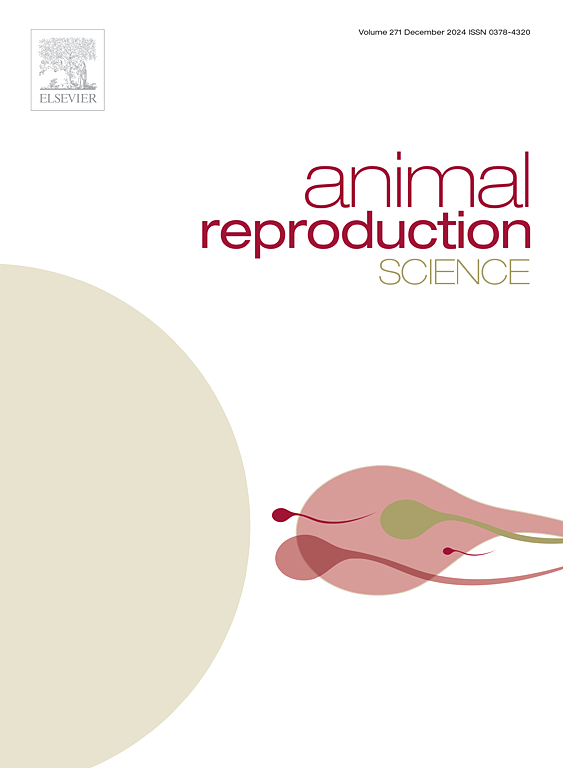Fibroblast growth factor 7 (FGF7) and its receptor FGFR2IIIb during the peri-implantation period of dromedary camels: A comparative analysis between left and right uterine horns
IF 2.2
2区 农林科学
Q1 AGRICULTURE, DAIRY & ANIMAL SCIENCE
引用次数: 0
Abstract
The peri-implantation period in dromedary camels is a critical phase in pregnancy establishment, yet molecular mechanisms governing uterine receptivity and embryo-maternal interactions remain poorly understood. This study investigates the expression and localization of Fibroblast Growth Factor 7 (FGF7) and its receptor FGFR2IIIb in the left (LUH) and right (RUH) uterine horns of pregnant dromedary camels. We examined endometrial, and conceptus tissues collected on Days 8, 10, and 12 post-ovulation (PO). Results revealed that FGF7 mRNA expression in the LUH progressively increased from Day 8, peaking on Day 12, whereas no significant changes were observed in the RUH. Immunohistochemical analysis confirmed higher FGF7 protein intensity in LUH, particularly on Day 12, with predominant localization in the glandular epithelium and blood vessels. However, FGFR2IIIb mRNA and protein expression remained stable on Days 8 and 10 but significantly increased on Day 12 in both uterine horns, with higher levels in the LUH. In conceptuses, FGF7 mRNA was not detected at any pregnancy stages, yet its protein was present on Day 12. Conversely, FGFR2IIIb mRNA and protein expressions were undetectable on Day 8 but showed gradual upregulation from Day 10, peaking on Day 12. In conclusion, the preferential upregulation of FGF7 and its receptor FGFR2IIIb in the LUH may have a crucial role in the higher implantation success in this uterine horn. These findings provide novel insights into the molecular regulation in both uterine horns during early pregnancy in dromedary camels and may aid in developing strategies to enhance reproductive efficiency in this species.
单峰骆驼左右子宫角植入期成纤维细胞生长因子7 (FGF7)及其受体FGFR2IIIb的比较分析
单峰骆驼的着床期是妊娠建立的关键阶段,然而控制子宫容受性和胚胎-母体相互作用的分子机制仍然知之甚少。本研究探讨了成纤维细胞生长因子7 (FGF7)及其受体FGFR2IIIb在妊娠单峰骆驼左(LUH)和右(RUH)子宫角的表达和定位。我们在排卵后第8、10和12天检查子宫内膜和受孕组织。结果显示,FGF7 mRNA在LUH中的表达从第8天开始逐渐增加,在第12天达到峰值,而在RUH中未观察到显著变化。免疫组织化学分析证实,LUH中FGF7蛋白强度较高,特别是在第12天,主要定位于腺上皮和血管。然而,FGFR2IIIb mRNA和蛋白的表达在第8天和第10天保持稳定,但在第12天,两个子宫角的FGFR2IIIb mRNA和蛋白的表达显著增加,其中LUH的表达水平更高。在妊娠期,未检测到FGF7 mRNA,但其蛋白在第12天存在。相反,FGFR2IIIb mRNA和蛋白的表达在第8天检测不到,但从第10天开始逐渐上调,在第12天达到峰值。综上所述,FGF7及其受体FGFR2IIIb在LUH中的优先上调可能对该子宫角较高的着床成功率起着至关重要的作用。这些发现为单峰骆驼妊娠早期双子宫角的分子调控提供了新的见解,并可能有助于制定提高该物种生殖效率的策略。
本文章由计算机程序翻译,如有差异,请以英文原文为准。
求助全文
约1分钟内获得全文
求助全文
来源期刊

Animal Reproduction Science
农林科学-奶制品与动物科学
CiteScore
4.50
自引率
9.10%
发文量
136
审稿时长
54 days
期刊介绍:
Animal Reproduction Science publishes results from studies relating to reproduction and fertility in animals. This includes both fundamental research and applied studies, including management practices that increase our understanding of the biology and manipulation of reproduction. Manuscripts should go into depth in the mechanisms involved in the research reported, rather than a give a mere description of findings. The focus is on animals that are useful to humans including food- and fibre-producing; companion/recreational; captive; and endangered species including zoo animals, but excluding laboratory animals unless the results of the study provide new information that impacts the basic understanding of the biology or manipulation of reproduction.
The journal''s scope includes the study of reproductive physiology and endocrinology, reproductive cycles, natural and artificial control of reproduction, preservation and use of gametes and embryos, pregnancy and parturition, infertility and sterility, diagnostic and therapeutic techniques.
The Editorial Board of Animal Reproduction Science has decided not to publish papers in which there is an exclusive examination of the in vitro development of oocytes and embryos; however, there will be consideration of papers that include in vitro studies where the source of the oocytes and/or development of the embryos beyond the blastocyst stage is part of the experimental design.
 求助内容:
求助内容: 应助结果提醒方式:
应助结果提醒方式:


